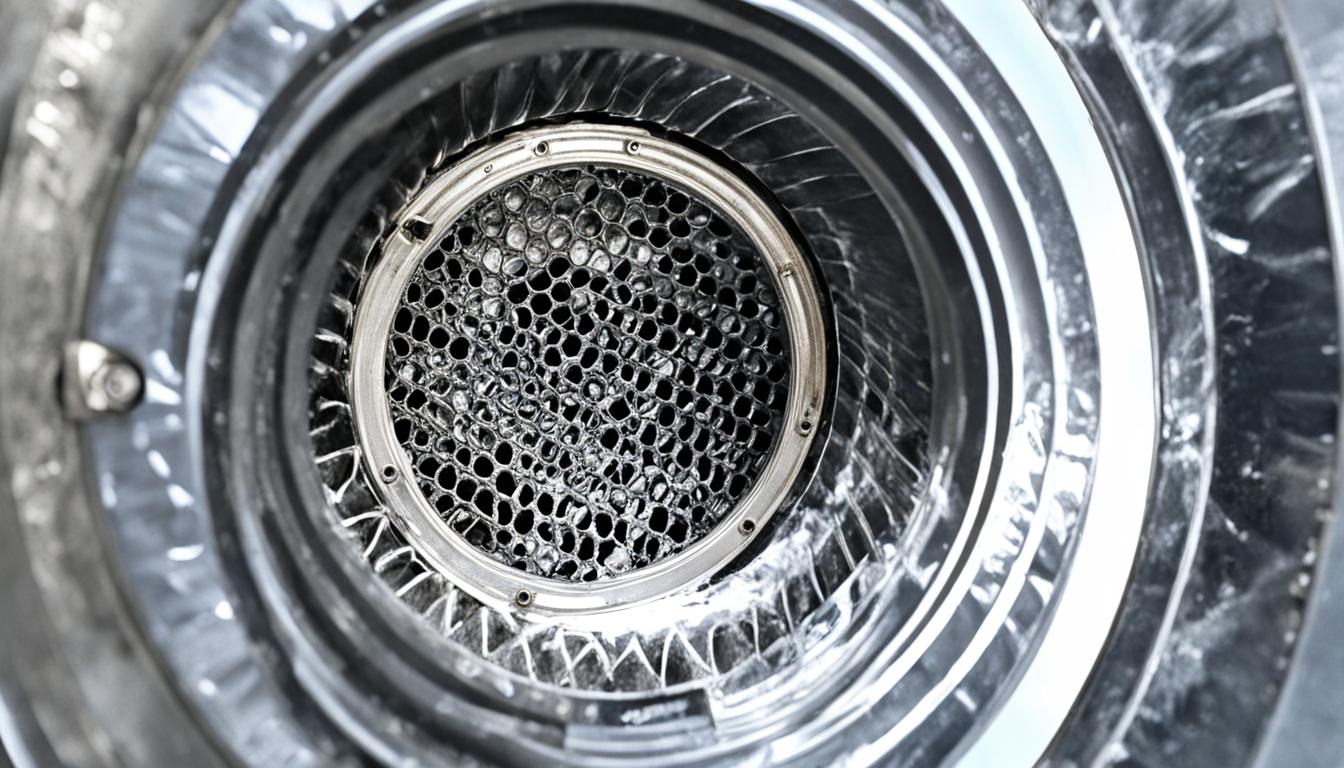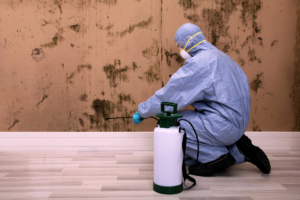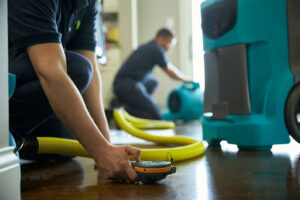Did you know that an estimated 2,900 home clothes dryer fires occur annually in the United States? These fires result in deaths, injuries, and millions of dollars in property damage. One of the leading causes of these fires is the accumulation of lint in the dryer vent, which can become highly flammable when exposed to high temperatures. Regularly cleaning your dryer vent is not only essential for fire safety but also for maintaining optimal dryer efficiency.
Key Takeaways:
- Cleaning your dryer vent regularly is crucial for fire safety and optimal dryer efficiency.
- An estimated 2,900 home clothes dryer fires occur annually in the United States.
- The accumulation of lint in the dryer vent can become highly flammable.
- Regular dryer vent cleaning reduces the risk of fires and ensures safe operation.
- Stay tuned to learn more about the importance of regular dryer vent cleaning and how to determine the ideal cleaning frequency.
The Importance of Regular Dryer Vent Cleaning
Regular dryer vent cleaning is crucial to prevent dryer vent fires and ensure the safe operation of your appliance. Lint accumulation in the dryer vent can be highly flammable, especially when exposed to high temperatures. When the vent becomes clogged, airflow is restricted, causing the dryer to overheat and increasing the risk of a fire.
According to the U.S. Fire Administration, an estimated 2,900 home clothes dryer fires occur annually, resulting in deaths, injuries, and millions of dollars in property damage. These fires can be prevented by routine cleaning of the dryer vent to remove lint and other debris that pose a fire hazard.
Cleaning your dryer vent on a regular basis reduces the risk of a fire and ensures the safe operation of your appliance. By maintaining a clean dryer vent, you can safeguard your home and protect your loved ones from the devastating consequences of a dryer vent fire.
Assessing How Frequently to Clean Your Dryer Vent
When it comes to determining how often to clean your dryer vent, it’s important to consider several factors that can impact the cleaning frequency. These factors include the number of people in your household and the frequency of dryer usage.
Larger households with more individuals generating laundry may need to clean their dryer vents more frequently. The increased volume of laundry can lead to a higher accumulation of lint and debris in the vent system, making regular cleaning essential to maintain optimal performance and safety.
On the other hand, homes with smaller families or less frequent dryer use may be able to adhere to the generally recommended annual cleaning schedule. A lower volume of laundry can result in less lint buildup in the vent system, reducing the need for more frequent cleanings.
Additionally, homes with pets may require more frequent cleaning of the dryer vent. Pet hair can become trapped in the vent system, increasing the risk of blockages and reducing airflow. Cleaning the vent more often can help prevent these issues and ensure the efficient operation of the dryer.
To determine the ideal cleaning frequency for your specific situation, evaluate the number of individuals in your home, the frequency of dryer usage, and the presence of pets. Adjust the cleaning schedule accordingly to maintain optimal performance, reduce the risk of fire hazards, and prolong the lifespan of your dryer.
Factors That Affect the Cleaning Schedule
Several factors can influence the cleaning schedule of a dryer vent. It’s important to consider these factors when determining the frequency of cleaning for your dryer vent to ensure optimal performance and safety.
- The length of the vent duct: Longer ducts are more prone to the accumulation of lint and debris, which can lead to clogging. As a result, longer vent ducts may require more frequent cleaning to maintain proper airflow. This is particularly relevant for homes with long vent systems.
- The configuration of the vent system: Vents with sharp bends or multiple turns can trap lint and impede airflow. These configurations can create areas where lint and debris are more likely to get stuck, requiring more frequent cleaning to prevent blockages.
- Impact of vent configuration on cleaning: The specific layout and design of the vent system can impact the effectiveness of cleaning. Some configurations may require more thorough cleaning techniques or specialized equipment to reach all areas and ensure proper removal of lint and debris.
- Dryer types and their byproducts: Certain dryer types, such as gas dryers, produce byproducts like carbon monoxide, which can accumulate in a clogged vent and pose health hazards. If you have a gas dryer, it may be necessary to clean the vent more frequently to prevent the buildup of these dangerous byproducts.
Considering these factors when establishing a dryer vent cleaning schedule will help you maintain a safe and efficient dryer system.
Professional vs. DIY: Cleaning Your Dryer Vent
When it comes to cleaning your dryer vent, you have two options: hiring a professional service or attempting the task yourself. Both choices have their advantages and considerations to keep in mind.
Professional Dryer Vent Cleaning:
If you opt for professional dryer vent cleaning, you can rely on the expertise and experience of trained professionals. These experts have the necessary knowledge and specialized equipment to thoroughly clean your vent system, ensuring optimal results.
Professional cleaners have access to powerful tools and techniques that can effectively remove lint, debris, and other obstructions from your dryer vent. They can also inspect the entire system for any potential issues or damages that may require maintenance or repairs.
By hiring professionals, you can save time and effort while achieving peace of mind, knowing that your dryer vent has been properly cleaned and inspected.
DIY Vent Cleaning:
On the other hand, if you choose to take the DIY route, you can save money by not hiring a professional service. DIY dryer vent cleaning can be cost-effective if you have the necessary time, effort, and access to the right tools.
However, it’s essential to note that DIY vent cleaning might not yield the same level of thoroughness and effectiveness as professional cleaning. Without the proper equipment and expertise, you may not be able to clear all the lint and debris from your vent system.
Moreover, attempting to clean your dryer vent yourself can be risky without proper safety precautions and guidelines. It’s crucial to follow safety guidelines and take necessary measures to avoid accidents or further damage to your vent system.
Ultimately, the decision between professional dryer vent cleaning and DIY depends on your preferences, budget, and available resources. If you prioritize convenience and want to ensure optimal results, professional vent cleaning is the recommended choice. However, if you’re confident in your abilities and willing to invest the time and effort, DIY vent cleaning can be a viable option.
You can see the image below to get a visual representation of the important factors to consider when choosing between professional and DIY dryer vent cleaning:
Maintaining Your Dryer Vent Between Cleanings
Proper maintenance of your dryer vent between cleanings can help extend its lifespan and reduce the risk of clogs. Here are some essential tips to keep your dryer vent in great condition:
- Dryer Vent Maintenance Tip 1: Regularly clean the lint trap after each dryer cycle to prevent lint from accumulating in the vent system. This simple step can significantly reduce the amount of lint that enters the vent and help maintain optimal airflow.
- Dryer Vent Maintenance Tip 2: Inspect and remove any lint buildup around the dryer exhaust vent on the outside of your home. Over time, lint can accumulate around the vent opening, restricting airflow and increasing the risk of clogs. Regularly clearing away this buildup can help ensure proper ventilation.
- Dryer Vent Maintenance Tip 3: Avoid overloading the dryer. When you overload the dryer with too many clothes, it impedes the airflow and can result in inadequate drying. Additionally, overloading can generate more lint, contributing to vent clogs. Be sure to follow the manufacturer’s recommendations for load capacity.
- Dryer Vent Maintenance Tip 4: Periodically check the vent duct for any signs of blockage or restricted airflow. Look for lint buildup, obstructions, or any damage that may hinder the smooth flow of air. If you notice any issues, address them promptly to avoid potential problems.
- Dryer Vent Maintenance Tip 5: Consider installing a vent hood or bird guard to prevent lint, debris, or animals from entering the vent during the vent. These simple additions can help keep your dryer vent clean and free from unwanted obstructions.
By following these maintenance tips, you can reduce the accumulation of lint in your dryer vent and maintain optimal airflow. Remember, regular maintenance is key to ensuring safety and efficient operation of your dryer.
Conclusion
Regularly cleaning your dryer vent is essential for both safety and optimal dryer performance. Neglecting to clean your dryer vent can increase the risk of a fire and reduce the efficiency of the appliance. It is recommended to have your dryer vent cleaned at least once a year, but factors such as household size, dryer usage, vent length, and configuration may require more frequent cleaning.
To ensure thorough and effective cleaning, you can consider hiring a professional vent cleaning service. Professionals have the experience and specialized equipment to properly clean the vent system and identify any potential issues or damages. Alternatively, you can choose to clean the dryer vent yourself, but make sure to follow proper safety precautions and guidelines.
In addition to regular cleaning, ongoing maintenance is important for preventing clogs and maintaining efficient airflow. Remember to clean the lint trap after each dryer cycle, inspect and remove any lint buildup around the dryer exhaust vent, and periodically check the vent duct for any signs of blockage or restricted airflow. By prioritizing regular dryer vent cleaning and maintenance, you can ensure the safety of your home and prolong the lifespan of your dryer.














